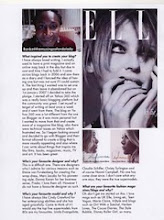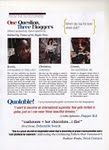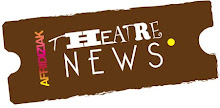Back in 2006 Slave to Fashion, a three part documentary was aired on Channel 4 which took a really good look at the fashion industry. It was hosted by TV presenter, June Sarpong and the aim was to make sense of the multi billion industry which everyone from the media to consumers seemed to be obsessed with. Slave to Fashion followed June as she roamed from New York to Paris and London, covered haute couture to high street via red carpet. The documentary kicked off at Paris Couture Week where June got the lowdown on the themes behind the concept of haute couture. She spoke to designers such as Christian Lacroix and Azzedine Alaia whp gave her the true meaning of what couture represents; a platform where the designer lets their ideas go wild. It is this image which they use to sell their brand through less expensive items such as perfumes and bags. What happens after this is that fashion editors from magazines and store buyers makes their interpretations of the looks. So the buyers from Zaks in New York and Selfridges in London will decide what trends are going to be hot for the following year and also editors from the likes of Vogue and Elle will decide what themes to use for editorial spreads. June then went off to Teen Vogue to talk to editor, Amy Astley to find out how she makes the transition from the catwalk look to an editorial shoot.
We were then taken to the other spectrum of magazines - advertisers - whose job it is to make sure we spend and spend. Journalist, Miranda Sawyer made a very important statement that people sell to women by making them feel insecure about themselves and then offer a cure in the form of a bag, perfume or dress. Which brought us onto the controversial topic of re-touching and whether magazines are perpetuated the myth of perfection.
June met up with hotshot photographer, John Rankin who took her through the process of re-touching and the extraordinary lengths which photo editors go to in order to remove every blemish from photos to ensure perfection. The programme then moved onto stylists who work for designers and the role they play in putting together looks for catwalk shows. Rachel Zoe and Patricia Fields were interviewed and added their thoughts on how their jobs impacted which pieces were picked for the shows. Then it was time for the models to get a look in as a few up and coming models were interviewed about what life strutting the catwalk was like. The model's role is pivitol as they are a blank slate on which designers promote and project their ideas. We then reach full circle with the cool hunters and fashion intelligence agencies whose business is keep an eye on what hip people are wearing on the streets. Companies such as these hire people to roam around cool cities and music festivals and take pictures of the cool and trendy and report back to designers who use this as a form of inspiration.
Part two looks at the relationship between celebrities and fashion and you can read it here.
Monday, 8 February 2010
Subscribe to:
Post Comments (Atom)



























5 cool comments:
It's never ceases to amaze me how much effort and time and people make up the fashion industry.
Great piece. Can't wait to see what you'll write about for part 2. I knew I was onto something years ago with these "trend" spotters. When I was a freelanced makeup artist for Nars back in 2000, I remember I was heavily into turquoise jewerly and wearing black. I used to wear this authentic Navajo Needpoint cuff all the time. That next year, turquoise jewelry was all the rage for that spring in 2001 into 2002. I'm not saying I single-handedly set a trend, but I do believe I was "spied on." Interesting...
Adrienne_S - I agree, people may scoff at the fashion industry and say it is all trivial but the fact it is, it is a multi billion industry that houses an awful lot of jobs. Also is responsible for giving cities global status.
Chic Chocolate - Yep they say that fashion goes round in circles and it really does with everyone borrowing ideas from each other.
This is a prime reason that people should never underestimate fashion. It is not a mindless or frivolous industry, like many try to make it out to be - it is one that provides hundreds of thousands of people with work each year, and is most definitely here to stay! :)
very interesting! i liked how you write this :)
Post a Comment